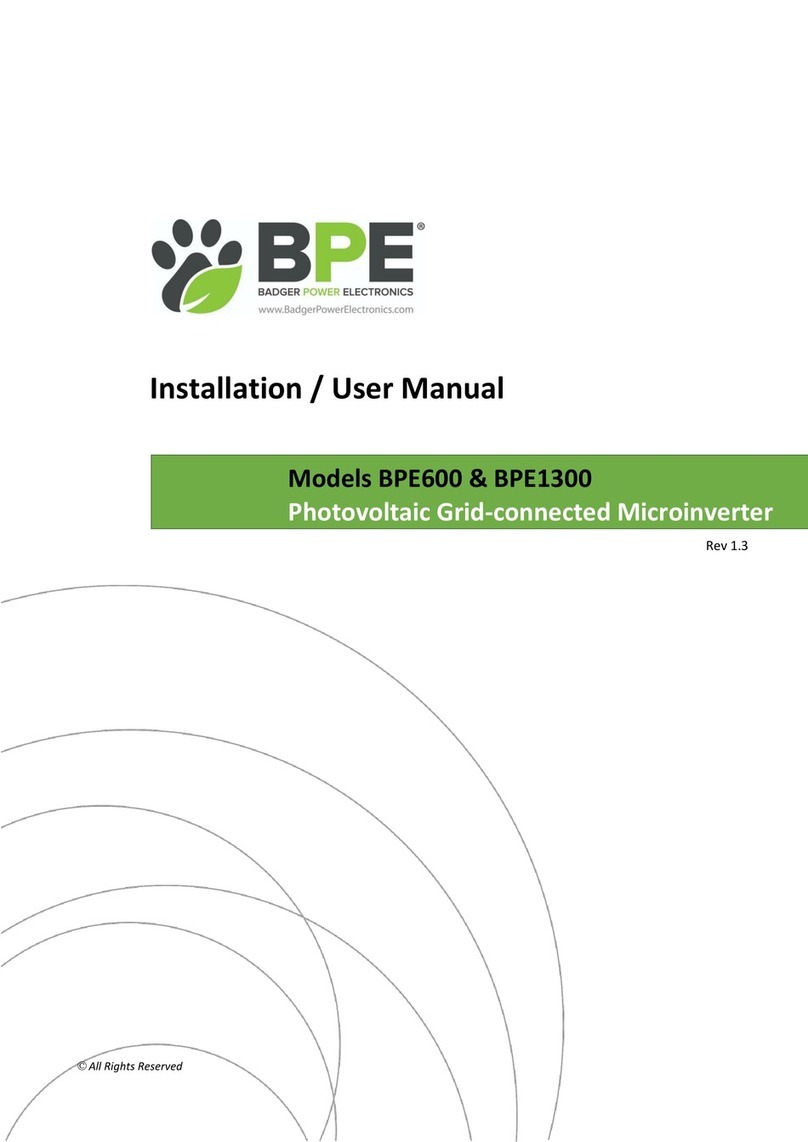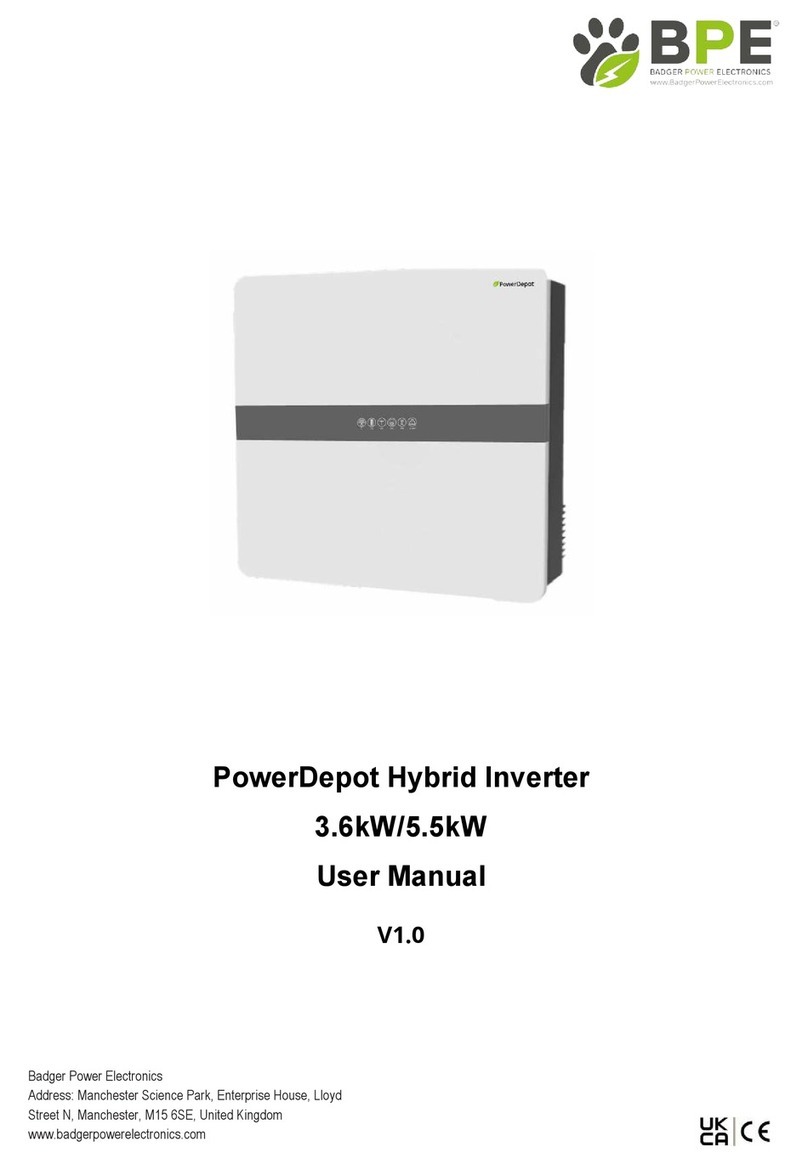
Programming Quick Start
Guide BPE Hybrid Inverter
System Work Mode
Battery Settings - Time Of Use
'EWKZdh^
Home Screen > System Work Mode
Export to Grid First - All excess power will be exported to the grid.
UPS Load Priority - The hybrid inverter will only power the loads connected to the load port and will not produce more power than the connected loads require.
This mode by default will export ZERO to the grid unless "Solar Export" is ticked.
Consumption Priority - The hybrid inverter will push power to the whole home load (this mode requires the included CT clamp) see page 13 of the user manual.
This mode by default will export ZERO to the grid unless "Solar Export" is ticked. WƌĞƐƐƚŚĞƚŝĐŬĂƚƚŚĞďŽƚƚŽŵŽĨƚŚĞƐĐƌĞĞŶƚŽƐĂǀĞLJŽƵƌƐĞůĞĐƚŝŽŶ
Home Screen > Battery Settings
Home Screen > System Work Mode > Arrow Down > Time Of Use Settings
This screen will allow you to set the parameters for discharging the battery
to the load and also charging the battery from the grid or a generator.
Once you have completed the above step and activated the Lithium battery
you will need to programme the time of use settings, selecting Time Of Use
will allow the battery to be discharged to the load until a user set SOC % is reached during the pre-set 6 time periods. You can also select whether you
want to charge the battery from the Grid or a Generator. For example, on the image to the left we have programmed the time of use to discharge the battery to the load
between 01.00am - 21.00pm until the battery SOC reaches 20% and then for the grid to fully charge the battery between 21.00pm and 01.00am. WƌĞƐƐƚŚĞƚŝĐŬĂƚƚŚĞ
ďŽƚƚŽŵŽĨƚŚĞƐĐƌĞĞŶƚŽƐĂǀĞLJŽƵƌƐĞůĞĐƚŝŽŶ
Home Screen > Gen Port Use
dŚĞ'EWKZdŝƐĂŵƵůƚŝĨƵŶĐƚŝŽŶŝŶƉƵƚŽƵƚƉƵƚŽĨĨĞƌŝŶŐϯĚŝĨĨĞƌĞŶƚĨƵŶĐƚŝŽŶƐ zŽƵĐĂŶƐĞůĞĐƚŽŶĞŽĨƚŚĞĨŽůůŽǁŝŶŐ
'ĞŶĞƌĂƚŽƌ/ŶƉƵƚ
^ŵĂƌƚ>ŽĂĚKƵƚƉƵƚͲdŚŝƐŵŽĚĞƵƚŝůŝƐĞƐƚŚĞ'ĞŶŝŶƉƵƚĐŽŶŶĞĐƚŝŽŶĂƐĂ^ŵĂƌƚ>ŽĂĚŽƵƚƉƵƚǁŚŝĐŚŽŶůLJƌĞĐĞŝǀĞƐƉŽǁĞƌǁŚĞŶƚŚĞƌĞŝƐĞdžĐĞƐƐƉŽǁĞƌŐĞŶĞƌĂƚŝŽŶĂŶĚƚŚĞďĂƚƚĞƌLJ
^KŝƐĂďŽǀĞĂƵƐĞƌƉƌŽŐƌĂŵŵĂďůĞƚŚƌĞƐŚŽůĚ dŚĞ'ĞŶŝŶƉƵƚƉŽƌƚŝŶƚŚĞƵƐĞƌĂƌĞĂŽĨƚŚĞƐLJƐƚĞŵďĞĐŽŵĞƐĂŶŽƵƚƉƵƚƚŽŚŝŐŚƉŽǁĞƌůŽĂĚƐƐƵĐŚĂƐĂǁĂƚĞƌŚĞĂƚĞƌŝƌƌŝŐĂƚŝŽŶ
ƉƵŵƉĂĐƵŶŝƚŽƌĂŶLJŽƚŚĞƌĚĞǀŝĐĞ
DŝĐƌŽ/Ŷǀ/ŶƉƵƚͲdŚŝƐǁŝůůĂůůŽǁĐŽƵƉůŝŶŐŽĨDŝĐƌŽ/ŶǀĞƌƚĞƌƐŽƌŐƌŝĚƚŝĞĚŝŶǀĞƌƚĞƌƐŝŶĂĚĚŝƚŝŽŶƚŽƚŚĞƌĂƚĞĚŝŶƉƵƚŽĨƚŚĞŝŶǀĞƌƚĞƌ
Press the tick at the bottom of the screen to save your selection.
Battery Settings
Installing the hybrid inverter with a BPE 4.8kWh battery with integrated BMS
Select "Lithium"
Set the battery parameters as in the image
Select "Activate Battery"
Press the tick at the bottom of the screen to save your selection.
When using Time Of Use function below you will first need to change the
default battery low % (page 3 in the battery settings LCD screen) to what you
would like the minimum SOC that the battery will discharge too, anything
below 20% can affect the life expectancy of the battery.
Press the tick at the bottom of the screen to save your selection.





























